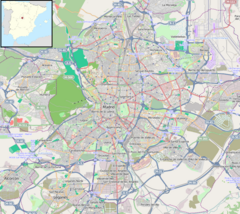
The Madrid Metro is a rapid transit system serving the city of Madrid, capital of Spain. The system is the 14th longest rapid transit system in the world, with a total length of 293 km (182 mi). Its growth between 1995 and 2007 put it among the fastest-growing networks in the world at the time. However, the European debt crisis greatly slowed expansion plans, with many projects being postponed and canceled. Unlike normal Spanish road and rail traffic, which drive on the right, Madrid Metro trains use left-hand running on all lines because traffic in Madrid drove on the left until 1924, five years after the system started operating.
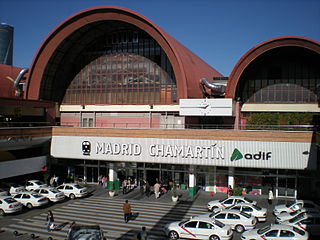
The Estación de Madrid-Chamartín Clara Campoamor or Madrid Chamartín is the second major railway station in Madrid, Spain. Located on the northern side of the city, it was built between 1970 and 1975, but more work was carried on into the early 1980s. It then superseded Atocha station, which is located just south of the city centre. However, as the AVE network expanded with a hub at Atocha, Chamartin again became Madrid's second station by passenger volume.
Estrella or La Estrella may refer to:
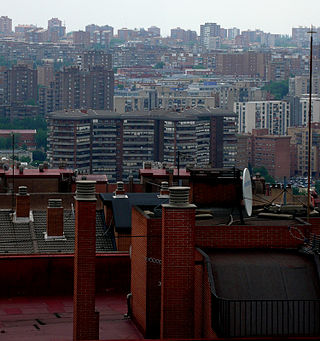
Moratalaz is a district of Madrid, Spain. It is a well-known area because musicians such as Melendi and Alejandro Sanz have lived there. Moratalaz is on east of municipality of Madrid. It has 6.34 km2 (2.45 sq mi) of surface area and is delineated by the highways of M-30 to the west, M-40 to the east, M23 to the north and A-3 to the south.

Cerro de la Estrella is an underground station along Line 8 of the metro of Mexico City. The station is located along the Calzada Ermita-Iztapalapa and serves the Colonia Hidalgo y Mina neighborhood within the Iztapalapa borough on the east side of the city. The station is named for the Cerro de la Estrella – a mesoamerican archaeological site located nearby. It was opened on 20 July 1994.
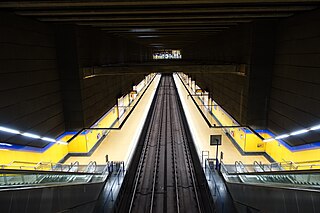
Valdebernardo is a station on line 9 of Madrid Metro which runs under Indalecio Prieto Boulevard, in the Vicálvaro district of Madrid district, serving the Valdebernardo barrio. It is located in fare Zone A.

Plaza de España-Noviciado is a station on the Madrid Metro. Line 2 serves Noviciado whilst Line 3 and Line 10 serves Plaza de España. It is located in fare Zone A. The twin stations are named for the Plaza de España and the Calle del Noviciado respectively.

Estación del Arte is a station on Line 1 of the Madrid Metro and is located in Fare Zone A. It was opened to the public on 26 December 1926. The station is located beneath Charles V plaza, less than 500 meters from the Madrid Atocha railway station which serves commuter and long-distance trains. It is the nearest Metro station to the Paseo del Prado. It is located between the neighborhoods of Embajadores (Centro), Jerónimos (Retiro) and Atocha (Arganzuela).

Tribunal is a station on Line 1 and Line 10 of the Madrid Metro. Originally opened under the name Hospicio, it has been operating since 1919. It is located in Zone A.

Núñez de Balboa is a station on Line 5 and Line 9 of the Madrid Metro. It is located in fare Zone A.

Sainz de Baranda is a station on Line 6 and Line 9 of the Madrid Metro, located at the intersection of Doctor Esquerdo and Alcalde Sainz de Baranda streets in the Retiro district in Madrid, Spain. It is located in fare Zone A. The station is named after the street, which in turn is named after the first mayor of Madrid, Pedro Sainz de Baranda.

Alonso Martínez is a station on Line 4, Line 5 and Line 10 of the Madrid Metro. It is located in Zone A.

Plaza de Castilla is a station on Line 1, Line 9 and Line 10 of the Madrid Metro. It is located in fare Zone A. It is located underneath the square of the same name, on the border between the districts of Tetuán and Chamartín.

La Estrella, also known as Ancón, is a station on line A of the Medellín Metro going south. It is located in the La Estrella municipality of Colombia. It was inaugurated on September 17, 2012 as part of the extension of the line from Itagüí in a ceremony attended by the current president of Colombia, Juan Manuel Santos; Governor of Antioquia, Sergio Fajardo; and Medellin Mayor Aníbal Gaviria.

Pinar de Chamartín is a station on the Madrid Metro, opened to the public on 4 November, 2007. It is located in fare Zone A and serves the area of Pinar de Chamartín.

Colombia is a station on Line 8 and Line 9 of the Madrid Metro, located under the calle de Colombia. It is in fare Zone A.

Concha Espina is a station on Line 9 of the Madrid Metro. It is located in fare Zone A.
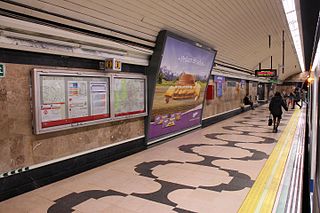
Artilleros is a station on Line 9 of the Madrid Metro, located under the Calle Pico de los Artilleros. It is located in fare Zone A.

Lomas Estrella is a station on Line 12 of the Mexico City Metro. The station is located between San Andrés Tomatlán and Calle 11. It was opened on 30 October 2012 as a part of the first stretch of Line 12 between Mixcoac and Tláhuac.
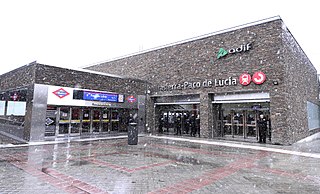
Paco de Lucía station completes extension of Line 9 of the Madrid Metro. It is located in fare Zone A and brings Metro to 50.000 new potential users. It opened on 25 March 2015, at the time making it station 301 of the Metro Madrid network. While the station's name was originally supposed to be Costa Brava, it is now named after Spanish musician and guitarist Paco de Lucía (1947–2014), a former resident of the district the station is located in, who died in 2014.

